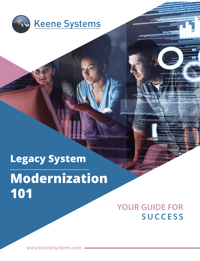At that point, you have a choice on your hands: you can simply update, modernize or outright replace your legacy systems, or continue to support those systems in some capacity. Somehow, there are people out there who see all of these very real dangers and still think it's a good idea to do the latter instead of the former. This, too, quickly becomes a nightmare for most companies.
For starters, continuing to support legacy applications on your own when they're no longer supported by the vendor means that you need to now go out and find someone who A) is familiar with the system you're talking about, and B) who has the skills and the expertise necessary to maintain it.
The issue with this approach is twofold. First, it's very difficult to find top tier talent with the type of experience necessary to offer the same quality assurance and uptime guarantees as you would get with a new application. If you do get lucky and manage to find that person, you're going to pay heavily for their services. Not only will you spend a significant amount of money searching for these people and onboarding them, but you'll need to continue to invest in training and other ongoing education concerns in the future. Needless to say, these costs will quickly add up.
But more than that, in many cases these legacy platforms will STILL not be supported on the operating systems you're using them on. This means that even if you find the most objectively perfect person to fill the role described above, you're still creating an enormous security risk for your business that you can never, ever 100% eliminate.
This type of scenario is challenging for a different reason, too. Oftentimes when dealing with technologies that are 10-years-old or older, the senior people within an organization who may have developed said platforms have long since moved into management and no longer want to go to the enormous amount of effort required to maintain the code. The younger people in the business are less likely to want to get involved with older technology in the first place, already being well aware that something far more viable and user friendly is available. This means that there is nobody left to maintain those systems - creating a perfect storm in the worst possible way.
This age vs. technology situation also extends to the independent contract programming market. For example, leading up to the year 2000, it was expected that many legacy systems would fail because of the Y2K date bug. Some dates were stored as only 2 digits, so what happens in date comparisons when “99” flips over to “00”? To make matters worse, if a year is divisible by 100, it is not a Leap Year unless it is also divisible by 400. No one ever wrote these simple rules into the software of the 1980’s & 90’s and these systems were expected to fail as the clock ticked over on New Year’s Eve 1999. When it came time to fix the date errors in thousands of legacy systems, the older programmers were no longer working in the field and the younger programmers wouldn’t touch the ancient technology even though companies were offering exorbitant fees.
But again - even if you somehow manage to circumnavigate all of these issues and find someone to maintain your legacy systems, these options are still not scalable, and they rely on individuals to support them indefinitely.

This is largely a “Band Aid” approach - you're treating the symptom, not the disease. All of the fundamental flaws of the legacy system still exist, and they will, forever. All you are doing at that point is delaying the inevitable.
Plus, the opportunity cost of not addressing the need sooner will continue to impact business productivity and growth, all while opening up your customers and markets to competition.
At this point, it's entirely possible that a business may not have the expertise to handle any of these concerns themselves - and they have never hired a programmer before, so they don't really know what that entails. Here, they usually make one of three mistakes: they either hire an independent consultant to maintain their legacy systems, hire a consulting firm to do the work, or find an off-the-shelf application and try to shoehorn it into their organization.
The problem with hiring an independent consultant is that they are only as good as the people who manage the project and have the skills to map your requirements to a solution. A failure at this part of the process can result in a solution that is worse than the one you are replacing, not better.
Hiring an independent consultant is simply not a scalable move, because there are only so many hours in a week to devote exclusively to your company.
Off-the-shelf software also creates its own share of gaps and rarely, if ever, solves the problem to begin with. It may solve 80% of the problems you're facing, sure - but that 20% that remains is what is unique to your business and that is not currently being addressed at all.













